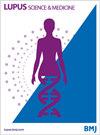Novel potential lncRNA biomarker in B cells indicates essential pathogenic pathway activation in patients with SLE
IF 3.7
2区 医学
Q1 RHEUMATOLOGY
引用次数: 0
Abstract
Objectives Systemic lupus erythematosus (SLE) is a highly heterogeneous disease, and B cell abnormalities play a central role in the pathogenesis of SLE. Long non-coding RNAs (lncRNAs) have also been implicated in the pathogenesis of SLE. The expression of lncRNAs is finely regulated and cell-type dependent, so we aimed to identify B cell-expressing lncRNAs as biomarkers for SLE, and to explore their ability to reflect the status of SLE critical pathway and disease activity. Methods Weighted gene coexpression network analysis (WGCNA) was used to cluster B cell-expressing genes of patients with SLE into different gene modules and relate them to clinical features. Based on the results of WGCNA, candidate lncRNA levels were further explored in public bulk and single-cell RNA-sequencing data. In another independent cohort, the levels of the candidate were detected by RT-qPCR and the correlation with disease activity was analysed. Results WGCNA analysis revealed one gene module significantly correlated with clinical features, which was enriched in type I interferon (IFN) pathway. Among non-coding genes in this module, lncRNA RP11-273G15.2 was differentially expressed in all five subsets of B cells from patients with SLE compared with healthy controls and other autoimmune diseases. RT-qPCR validated that RP11-273G15.2 was highly expressed in SLE B cells and positively correlated with IFN scores (r=0.7329, p<0.0001) and disease activity (r=0.4710, p=0.0005). Conclusion RP11-273G15.2 could act as a diagnostic and disease activity monitoring biomarker for SLE, which might have the potential to guide clinical management. Data are available in a public, open access repository. All data relevant to the study are included in the article or uploaded as supplementary information.B 细胞中新的潜在 lncRNA 生物标记物表明系统性红斑狼疮患者的重要致病途径被激活
目的 系统性红斑狼疮(SLE)是一种高度异质性疾病,B 细胞异常在系统性红斑狼疮的发病机制中起着核心作用。长非编码 RNA(lncRNA)也与系统性红斑狼疮的发病机制有关。lncRNA的表达受到精细调控,且与细胞类型有关,因此我们旨在鉴定B细胞表达的lncRNA作为系统性红斑狼疮的生物标志物,并探索它们反映系统性红斑狼疮关键通路和疾病活动状态的能力。方法 采用加权基因共表达网络分析(WGCNA)将系统性红斑狼疮患者的B细胞表达基因聚类为不同的基因模块,并将它们与临床特征联系起来。根据 WGCNA 的结果,在公开的大量和单细胞 RNA 序列数据中进一步探索了候选 lncRNA 的水平。在另一个独立队列中,通过 RT-qPCR 检测候选基因的水平,并分析其与疾病活动的相关性。结果 WGCNA 分析发现了一个与临床特征显著相关的基因模块,该模块富含 I 型干扰素(IFN)通路。在该模块的非编码基因中,lncRNA RP11-273G15.2在系统性红斑狼疮患者与健康对照组和其他自身免疫性疾病患者的五个B细胞亚群中都有不同程度的表达。RT-qPCR 验证了 RP11-273G15.2 在系统性红斑狼疮 B 细胞中高表达,并与 IFN 评分(r=0.7329,p<0.0001)和疾病活动性(r=0.4710,p=0.0005)呈正相关。结论 RP11-273G15.2可作为系统性红斑狼疮的诊断和疾病活动监测生物标志物,具有指导临床治疗的潜力。数据可在公开、开放的资源库中获取。所有与研究相关的数据均包含在文章中或作为补充信息上传。
本文章由计算机程序翻译,如有差异,请以英文原文为准。
求助全文
约1分钟内获得全文
求助全文
来源期刊

Lupus Science & Medicine
RHEUMATOLOGY-
CiteScore
5.30
自引率
7.70%
发文量
88
审稿时长
15 weeks
期刊介绍:
Lupus Science & Medicine is a global, peer reviewed, open access online journal that provides a central point for publication of basic, clinical, translational, and epidemiological studies of all aspects of lupus and related diseases. It is the first lupus-specific open access journal in the world and was developed in response to the need for a barrier-free forum for publication of groundbreaking studies in lupus. The journal publishes research on lupus from fields including, but not limited to: rheumatology, dermatology, nephrology, immunology, pediatrics, cardiology, hepatology, pulmonology, obstetrics and gynecology, and psychiatry.
 求助内容:
求助内容: 应助结果提醒方式:
应助结果提醒方式:


